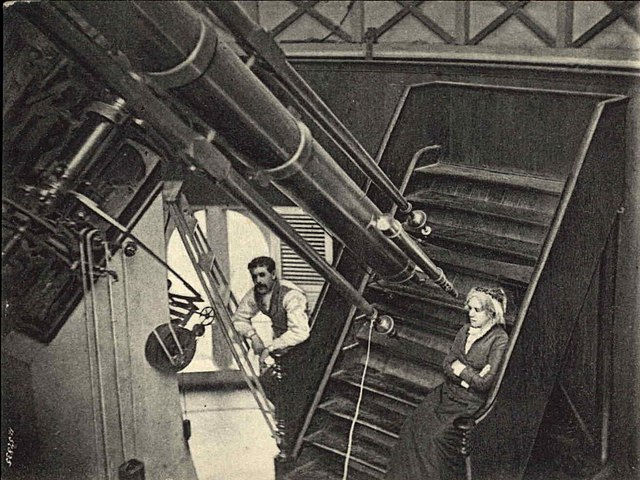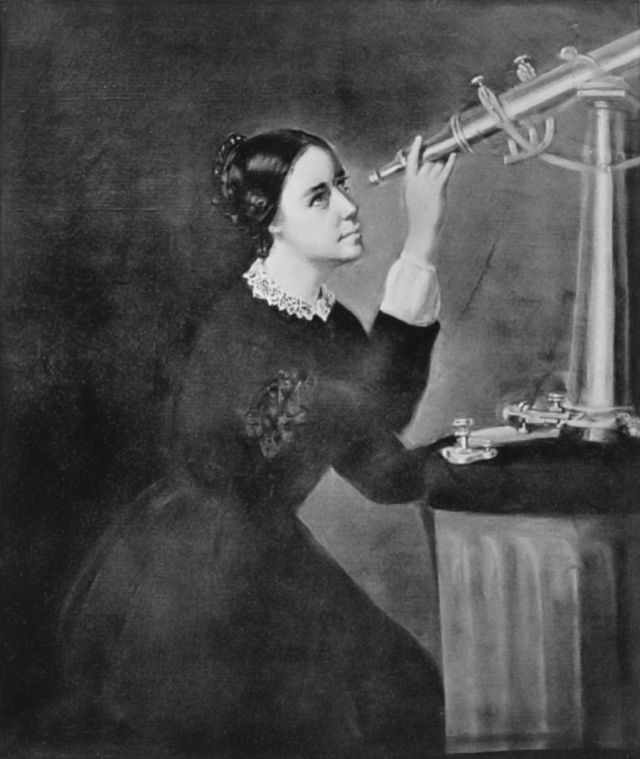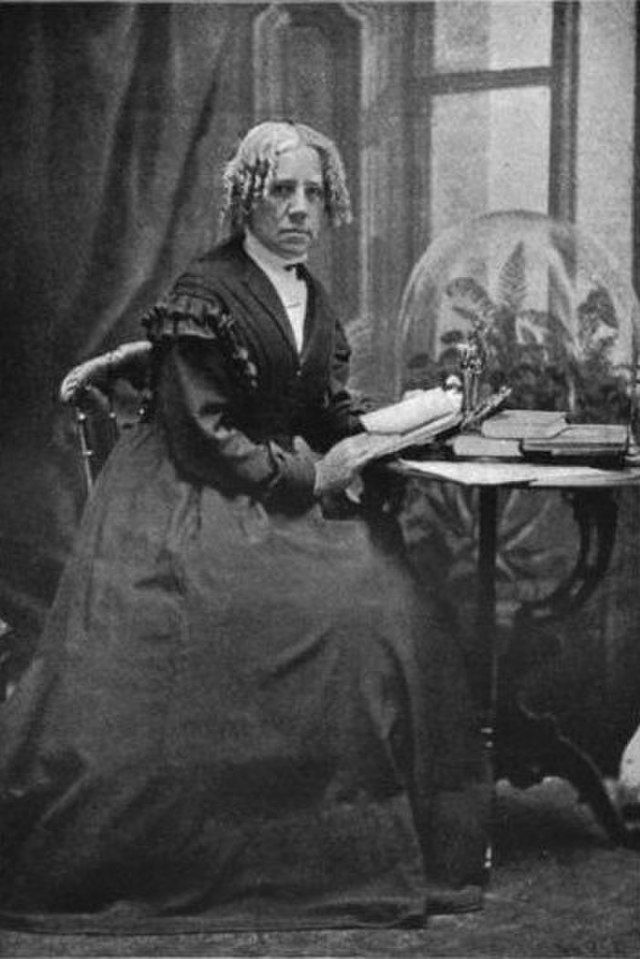Computing Venus: The Trailblazing Path of Maria Mitchell
- Dale DeBakcsy

- Apr 24, 2023
- 6 min read
In the early nineteenth century nothing about the island of Nantucket made sense. It was simultaneously a hotbed of Quakerism and of the notoriously bawdy and violent whaling industry, a deeply conservative and god-fearing community that was at the same time at the fore-front of gender equality in education and racial justice. For a few decades, before the collapse of the whaling industry and the ruin of Civil War, it was a place where just about anything could be expected to happen, and in 1847, it was here that American astronomy began, at the telescope of Maria Mitchell (1818–1889).
Mitchell was born in 1818 to a thoroughly unconventional Quaker family. Her mother had the reputation of having read every book on the island, and her father was one of America’s first astronomers of note, as well as an amateur barrel-maker, bank president, schoolmaster, and maritime instrument synchroniser. The parents and their multiple offspring all crammed together in a miniscule house with a makeshift observatory on the roof and, come nightfall, one child or other would gather on the perilously thin planking and aid William Mitchell’s observations. One child, however, was his particular helper- his daughter, Maria.
Quakers had a long standing tradition of equal education for girls and boys, so there was nothing so unusual about Maria’s learning the astronomical trade at her father’s side. If anything, the community as a whole took pride in her evident scientific gifts, allowing her to become a member of their scientific society at the age of twelve, and putting her in charge of the Athenaeum, the library for the island’s intellectual set, at the age of eighteen. Science and poetry and history and languages were all taken very seriously by the Quaker community, and if somebody excelled, regardless of their gender, they were celebrated.
At the Athenaeum, Maria spent her time learning the mathematics which her father had never mastered and which would allow her to be a mathematical astronomer and not just a dedicated collector of data. Already in her teens, she was setting herself, and as a consequence American astronomy, down a road that would forever separate it from its Earnest Amateur past. While she would continue working with her father for the rest of his long life, her ability to not only rigorously collect data, but to interpret it to calculate elliptical and hyperbolic trajectories, would soon make her the senior partner in their endearing collective work.

She ran the library, helped synchronise the whaling industry’s chronometers, and performed odd jobs for the Navy, all very honourable and engaging work that would have seen her through to a quiet and modest retirement. But then, in 1847, on one of her nightly sky sweeps, she noticed something that had not been there before. It was a hyperbolic comet, and she was the first in the world to observe it. With natural Quaker modesty, she wanted to keep the discovery quiet, but her father, knowing what it might mean to the nascent American astronomical community, communicated Maria’s data to Harvard, which rushed it to the British and Dutch astronomical authorities.
Maria’s comet, together with her impeccable work in plotting its hyperbolic orbit, was the first real feather in the American astronomical cap, and made her an instant celebrity. In the summer, hundreds of tourists would descend on the Athenaeum for a chance to see her or collect her autograph. Newspapers ran stories about the Quaker astronomer who found a new heavenly body from her father’s roof. More practically, a job offer came in paying a handsome $500 a year (her work at the library paid only one hundred, and her eventual professorship at Vassar only eight hundred) to accurately plot the course of Venus for the purposes of navigation. That work would last nineteen years, and make Maria Mitchell one of the few professional astronomers in the entire country.
It was, all things considered, a good time to be a woman in astronomy in America. The sciences were not professionalised as of yet, which meant low or no salaries and therefore low to no interest in claiming that intellectual ground as a solely male pursuit. Ideologically, math and science in these pre-Darwin years were held to be relatively non-controversial paths to follow compared to the socialist and abolitionist rumblings of the humanities and so, while men were encouraged to study poetry and philosophy, women were positively thrust at the sciences in an amateur capacity. Collect flowers and stargaze by all means, as long as it keeps you from reading John Stuart Mill. For some time, Vassar’s curriculum was scientifically the most robust in the country, and many women’s colleges boasted more classes devoted to astronomy and biology than classics-leaning Harvard or Yale. Mitchell was the greatest and most esteemed fruit of these years of women’s scientific education, and had the great misfortune to live to see the doors of science closed firmly against women after the Civil War.

During the war, the planning of Vassar (founded 1861 with the first students matriculating in 1865) as an exclusively women’s college put a bold new idea at the heart of the educational system. Mitchell was invited to join the faculty as an astronomy professor at a salary of $1500. She protested that she didn’t feel herself worth that much and they, somewhat shamefully, said, ‘Great! How’s about we pay you $800 instead?’ She accepted, not aware that even the least experienced of male professors had been offered $2000 a year. She was given a place to sleep in the school’s observatory which turned out to be a cot set up in the office she was expected to teach students in, an indignity that lasted for ten years until they finally made up an old coal closet with a bed to serve as her room. Her widowed father lived with her, Nantucket having more or less disintegrated under the social and economic pressures of the Civil War, and together they had a grand time acting as mentors to an aspiring crop of female astronomers.
In fact, Mitchell felt her role as educator so important that she took the radical step of diminishing her research projects so as to put more time into fostering the practical development of her students. They were welcome in the observatory at all hours, and only after the last had gone would Mitchell eke out some observations of her own. She still published regularly, but nothing of a particularly daring scope, her time given instead to devising ways to better teach her charges, to changing the classroom from a lecture-heavy format to one of practical applications and conversational interaction.
And Mitchell had one more concern, too. In 1873, Edward Clarke wrote a book, Sex in Education, which contained a troubling claim about the link between infertility and women’s education. While becoming educated, Clarke argued, blood rushes from the uterus to the brain. The lack of uterine blood causes that organ to shrivel, creating first infertility and eventually effective hermaphroditism. Laughable today, this theory was taken very seriously at the time and, combined with the institutionalisation of science which made research jobs desirable for males, the press was on to push women out of scientific work. Mitchell fought back, serving as president of the Association for the Advancement of Women and working with leading feminist authors to organise a gathering of scientific data with which to refute Clarke’s biological evidence.

While still famous and respected herself, Mitchell watched her pool of once talented, undefeatable students dwindle. Those who remained in astronomy faced familial persecution and a massively unsure future, the few available research jobs in their field being handed out to males while women were relegated to the role of photographic plate computers. Frustrated at the sight of an astronomical establishment which she helped put on the map turning so resolutely away from the eager spirits who had guided its first steps, and seeing nothing but further decline in the future, Mitchell retired from Vassar in 1888, and was dead a year later, carried off by a mysterious mental disease – possibly the same heart-breaking dementia that had taken her mother’s life years before.
She was hailed in the papers for her life’s work even as the male astronomical community efficiently closed ranks in the space left empty by her absence. Mitchell’s legacy would be valiantly continued at Vassar by her student Mary Whitney, who published over a hundred scientific papers, each a defiant cry that the spirit of Maria Mitchell was, contrary to all evidence and the best efforts of an entire academic discipline, still alive.
FURTHER READING:
Maria Mitchell and the Sexing of Science by Renee Bergland is an at times brilliant, at times frustrating book. When it's at its best, detailing the surprising complexities of Nantucket Quaker life, and Maria Mitchell’s place within both it and the larger ante-bellum American scientific community, there are few books better. When it broadens its scope, however, it tends to lose focus and say regrettable things, from the thoroughly incorrect and insulting portrayal of Ellen Swallow Richards’s foundational contributions to chemistry and ecology as non-rigorous and uninspired dawdling, to the less maddening but no less wrong portrayal of the bawdy Christina of Sweden as an ‘ascetic’. Still, those moments are a small price to pay for the new vistas of insight into American science that Bergland offers.
And if you'd like to read more about women astronomers like Jill Tarter, check out my History of Women in Astronomy and Space Exploration, which you can order from Amazon, or from Pen and Sword US or UK.





Comments